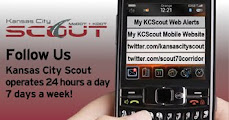
Posted by Nancy Powell
Scout Traffic Management Center Supervisor
Scout Traffic Management Center Supervisor
Blessed are we in KC for the fabulous weather we’ve been enjoying this fall season. Temperatures in the 70’s at mid-November are worth noting. With Thanksgiving behind us, the threat of severe weather arriving in the Metro is a likely possibility before long.

Use these waning days of November to prepare for the treacherous driving days ahead when temperatures at or barely below 32 degrees can cause a thin layer of water on the roadway to quickly become dangerously icy and slick. Make a quick review of your vehicle’s Owner’s Manual. Not all vehicles operate the same under adverse conditions. Always allow extra distance of at least 3 car lengths between the vehicle in front of you to permit safe stops when roads are icy or slick.
Vehicles equipped with Anti-Lock Braking Systems (ABS) require steady pressure to the brake pedal during the entire stop. Never manually pump ABS brakes yourself. Vehicles can be steered out of a skid by slowly removing your foot from the accelerator, until traction control occurs, then slowly turn the steering wheel in the direction you want your front wheels to go. Do not attempt to apply brakes.
When driving uphill on ice, choose a path that will allow optimum traction. Monitor the vehicles in front of you and avoid areas where they spin out or slide backward. Traction is also enhanced by maintaining adequate tire pressure. During icy weather conditions, drive slowly, turn slowly and brake slowly. Avoid sudden changes that can create loss of control.
Prepare an emergency kit for your vehicle, stocked with battery jumper cables, first aid supplies, blankets and extra outer wear, flashlight, shovel and basic hand tools. A fully charged cell phone is a lifesaver in an emergency; just don’t use it to text while driving. No message you could possibly send or receive is that urgent that it can’t wait until you’ve safely navigated the road and are not a hazard to yourself or others. Check out this MoDOT youtube.com video clip for a quick winter driving refresher. It may be the 90 seconds that saves a life this winter season!
http://www.youtube.com/watch?v=kZP88bGjmYc&feature=youtu.be>
Season’s Greetings from your friends at KC Scout!
Vehicles equipped with Anti-Lock Braking Systems (ABS) require steady pressure to the brake pedal during the entire stop. Never manually pump ABS brakes yourself. Vehicles can be steered out of a skid by slowly removing your foot from the accelerator, until traction control occurs, then slowly turn the steering wheel in the direction you want your front wheels to go. Do not attempt to apply brakes.
When driving uphill on ice, choose a path that will allow optimum traction. Monitor the vehicles in front of you and avoid areas where they spin out or slide backward. Traction is also enhanced by maintaining adequate tire pressure. During icy weather conditions, drive slowly, turn slowly and brake slowly. Avoid sudden changes that can create loss of control.
Prepare an emergency kit for your vehicle, stocked with battery jumper cables, first aid supplies, blankets and extra outer wear, flashlight, shovel and basic hand tools. A fully charged cell phone is a lifesaver in an emergency; just don’t use it to text while driving. No message you could possibly send or receive is that urgent that it can’t wait until you’ve safely navigated the road and are not a hazard to yourself or others. Check out this MoDOT youtube.com video clip for a quick winter driving refresher. It may be the 90 seconds that saves a life this winter season!
http://www.youtube.com/watch?v=kZP88bGjmYc&feature=youtu.be>
Season’s Greetings from your friends at KC Scout!





